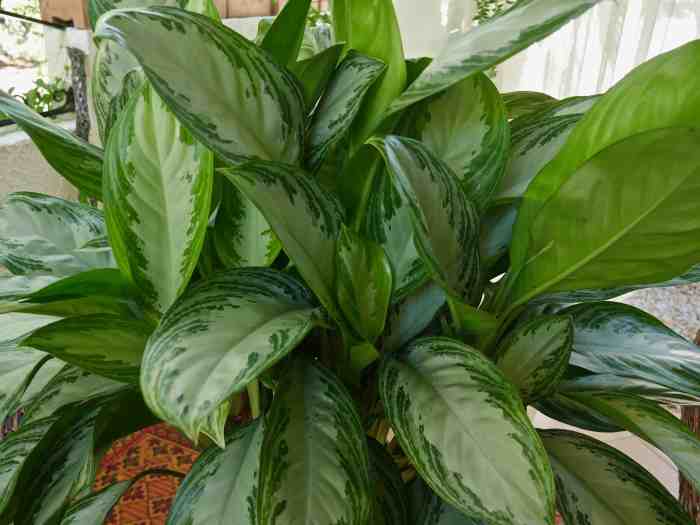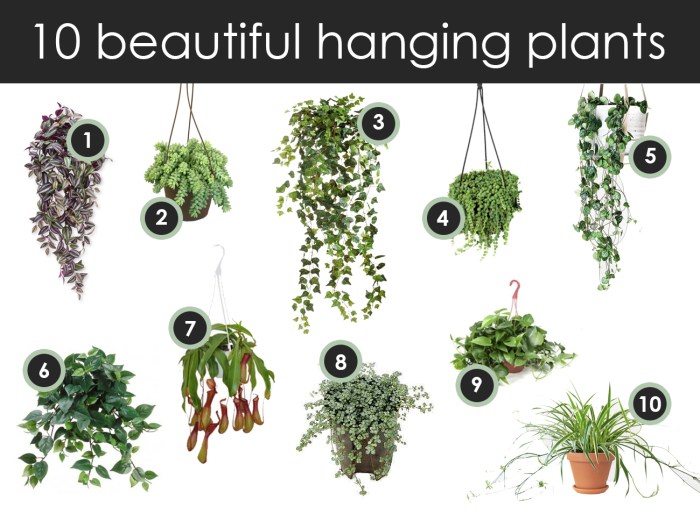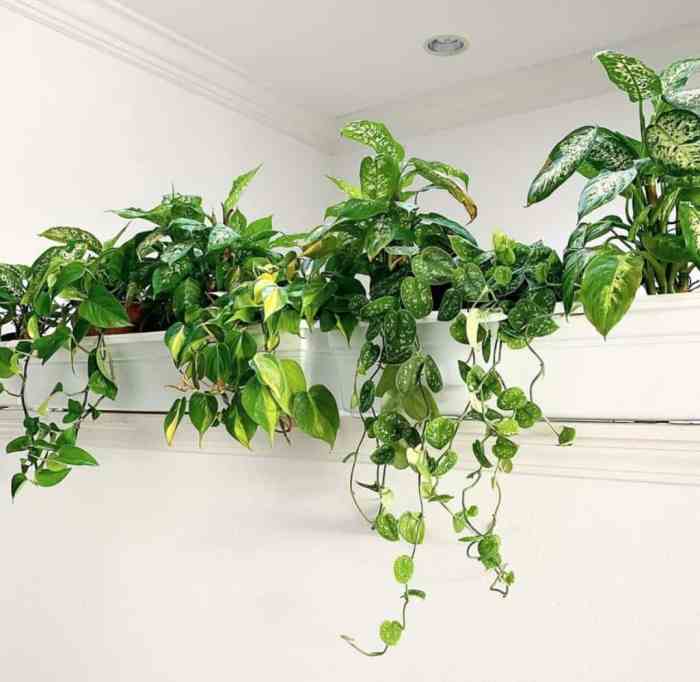Embark on a botanical journey with 10 hanging plants low sunlight, transforming your living spaces into vibrant havens of greenery. These resilient plants thrive in dimly lit corners, adding a touch of nature’s tranquility to your home.
Discover the enchanting world of low-light hanging plants, where lush foliage cascades gracefully, creating a symphony of textures and colors.
Suitable Plant Options

Hanging plants can add a touch of greenery and life to any room, even those with low light. Here are 10 low-light hanging plants that are easy to care for and will thrive in shady conditions:
The following table provides a list of 10 low-light hanging plants, including their scientific names, common names, and brief descriptions:
Plant Options Table
| Scientific Name | Common Name | Description |
|---|---|---|
| Epipremnum aureum | Golden pothos | A fast-growing vine with heart-shaped, variegated leaves |
| Philodendron hederaceum | Heartleaf philodendron | A trailing vine with heart-shaped, glossy leaves |
| Scindapsus pictus | Silver pothos | A slow-growing vine with variegated leaves that have silvery-green and dark green markings |
| Chlorophytum comosum | Spider plant | A rosette-forming plant with long, arching leaves that produce plantlets at the tips |
| Pellaea rotundifolia | Button fern | A fern with round, button-shaped leaves |
| Asplenium nidus | Bird’s nest fern | A fern with large, leathery leaves that form a cup-shaped rosette |
| Adiantum raddianum | Maidenhair fern | A fern with delicate, lacy fronds |
| Nephrolepis exaltata | Boston fern | A fern with long, arching fronds that are deeply divided |
| Hoya carnosa | Wax plant | A succulent vine with thick, waxy leaves |
| Peperomia obtusifolia | Baby rubber plant | A small, bushy plant with thick, oval leaves |
Hanging Methods

Hanging plants can add a touch of greenery and life to any room, but choosing the right hanging method is important to ensure the health and safety of your plants. There are several different methods for hanging plants, each with its own advantages and disadvantages.
Macrame
Macrame is a type of knotting that can be used to create beautiful and intricate plant hangers. Macrame hangers are typically made from natural materials like cotton or jute, and they can be customized to fit any size or shape of pot.
Advantages:
- Macrame hangers are very decorative and can add a touch of bohemian style to any room.
- They are adjustable, so you can hang your plants at any height.
- Macrame hangers are relatively easy to make, and there are many tutorials available online.
Disadvantages:
- Macrame hangers can be time-consuming to make.
- They can be difficult to clean, especially if they are made from natural materials.
Materials needed:
Low light conditions can be challenging for indoor plants, but there are a number of options available for those looking to add some greenery to their space. For those with limited natural light, consider hanging plants that thrive in low light conditions, such as pothos, snake plants, and ZZ plants.
For more inspiration, explore 10 hanging plants indoor ideas that will brighten up any room, regardless of the amount of sunlight available.
- Macrame cord
- Scissors
- Measuring tape
- Beads or other embellishments (optional)
Care and Maintenance

Ensuring the health and vitality of low-light hanging plants requires proper care and maintenance. This involves understanding their specific watering, fertilizing, and pruning needs, as well as providing adequate drainage and air circulation.
Watering
Low-light hanging plants generally have lower water requirements compared to their sun-loving counterparts. Allow the soil to dry out slightly between waterings, as overwatering can lead to root rot. Check the soil moisture by inserting your finger about an inch deep.
If the soil feels dry, it’s time to water.
Fertilizing
Fertilize low-light hanging plants sparingly, about once a month during the growing season. Use a balanced liquid fertilizer diluted to half strength. Avoid over-fertilizing, as it can burn the plant’s roots.
For those seeking greenery in their living spaces, hanging plants offer a unique and stylish solution, especially in low-light conditions. From the delicate spider plant to the lush pothos, there are a variety of low-maintenance options available. Explore a wider selection of hanging plants suitable for apartment living , where limited sunlight is not a hindrance to creating a verdant indoor oasis.
Returning to the topic of low-light hanging plants, the snake plant and ZZ plant stand out for their exceptional tolerance to neglect, making them ideal for those with busy schedules or limited experience in plant care.
Pruning
Regular pruning helps maintain the shape and health of low-light hanging plants. Remove any dead or damaged leaves or stems. You can also prune back leggy growth to encourage bushier growth.
Drainage and Air Circulation
Proper drainage is crucial for low-light hanging plants. Ensure the pot has drainage holes to allow excess water to escape. Good air circulation helps prevent fungal diseases. Keep the plants spaced apart and avoid overcrowding.
Styling and Placement

Hanging plants in low-light environments offer unique opportunities to add greenery and style to your home. Consider the following tips for styling and placement:
The amount of light available will impact the placement of your hanging plants. Plants that require brighter indirect light, such as pothos or philodendron, can be placed closer to windows or in areas with skylights. Plants that tolerate lower light levels, such as snake plants or ZZ plants, can be placed further away from light sources.
For those seeking a touch of greenery in low-light areas, 10 hanging plants low sunlight offer a solution. These plants thrive in shaded environments, adding a touch of nature to dimly lit corners. From the elegant trailing vines of the spider plant to the lush foliage of the peace lily, these plants bring life to any space.
For those looking for a more traditional approach, real hanging plants offer a timeless charm. Whether you opt for cascading ferns or vibrant succulents, 10 hanging plants low sunlight provide a touch of beauty and tranquility to any indoor setting.
Room Size
The size of your room will also influence plant placement. In smaller rooms, a single hanging plant can make a statement. In larger rooms, you may want to group several hanging plants together to create a more dramatic effect.
Plant Size
The size of your hanging plants should be in proportion to the size of your room. Smaller plants can be used to add a touch of greenery to a small space, while larger plants can make a bold statement in a larger room.
Focal Point
Hanging plants can be used to create a focal point in a room. Place a single hanging plant in the center of a room or above a piece of furniture to draw attention to it.
For those seeking lush greenery without ample sunlight, “10 Hanging Plants Low Sunlight” offers an ideal solution. These resilient plants thrive in shaded areas, adding a touch of nature indoors. However, for those seeking herbs that can be grown in hanging baskets, 10 Hanging Plants Herbs provides a comprehensive guide to fragrant and flavorful varieties that can enhance both culinary creations and the ambiance of any space.
The guide covers a wide range of herbs, from classic basil and thyme to unique options like oregano and lavender, ensuring that every taste and need is met. These hanging plants not only add a touch of freshness but also provide a convenient and space-saving way to cultivate herbs indoors, making them a perfect choice for urban gardeners and those with limited space.
Vertical Interest
Hanging plants can be used to add vertical interest to a room. Place hanging plants at different heights to create a layered look.
Troubleshooting Common Problems: 10 Hanging Plants Low Sunlight
Hanging plants in low-light conditions can face unique challenges that require prompt attention to prevent decline or loss. Common issues include yellowing leaves, pests, and disease, which can be effectively addressed with proper care and maintenance.
Yellowing Leaves
- Cause:Overwatering, insufficient light, nutrient deficiency
- Solution:Adjust watering schedule, provide more indirect light, fertilize regularly
Pests, 10 hanging plants low sunlight
- Cause:Aphids, mealybugs, spider mites
- Solution:Use insecticidal soap or neem oil, isolate infected plants
Disease
- Cause:Root rot, fungal infections
- Solution:Improve drainage, remove diseased leaves, apply fungicide if necessary
Wrap-Up
Whether you’re a seasoned plant enthusiast or a budding gardener, these 10 hanging plants low sunlight offer an effortless way to elevate your home’s ambiance. Embrace the beauty of nature indoors, and let these botanical wonders bring a touch of serenity and style to your everyday life.
Answers to Common Questions
Which hanging plant is best for beginners?
Pothos, also known as devil’s ivy, is a highly adaptable and low-maintenance plant, making it an excellent choice for beginners.
How often should I water low-light hanging plants?
Water your low-light hanging plants only when the soil feels dry to the touch. Overwatering can lead to root rot.
Can I hang my plants in a bathroom with no windows?
Some low-light hanging plants, such as ferns and spider plants, can tolerate the humid conditions of a bathroom without windows. However, they may require occasional supplemental lighting.